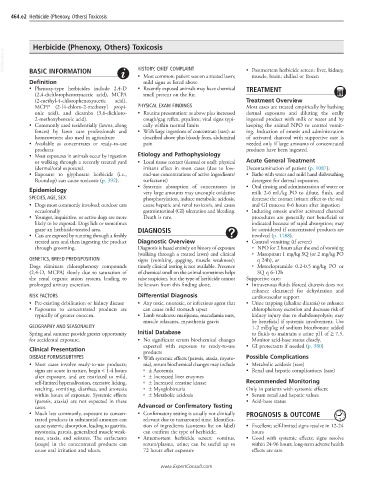Page 946 - Cote clinical veterinary advisor dogs and cats 4th
P. 946
464.e2 Herbicide (Phenoxy, Others) Toxicosis
Herbicide (Phenoxy, Others) Toxicosis
VetBooks.ir
HISTORY, CHIEF COMPLAINT
BASIC INFORMATION
• Most common: patient was on a treated lawn; • Postmortem herbicide screen: liver, kidney,
muscle, brain; chilled or frozen
Definition mild signs as listed above
• Phenoxy-type herbicides include 2,4-D • Recently exposed animals may have chemical TREATMENT
(2,4-dichlorophenoxyacetic acid), MCPA smell present on the fur.
(2-methyl-4-chlorophenoxyacetic acid), Treatment Overview
MCPP (2-[4-chloro-2-methoxy] propi- PHYSICAL EXAM FINDINGS Most cases are treated empirically by bathing
onic acid), and dicamba (3,6-dichloro- • Routine presentation: as above plus increased dermal exposures and diluting the orally
2-methoxybenzoic acid). cough/gag reflex, ptyalism; vital signs typi- ingested product with milk or water and by
• Commonly used residentially (lawns, along cally within normal limits keeping the animal NPO to control vomit-
fences) by lawn care professionals and • With large ingestions of concentrate (rare): as ing. Induction of emesis and administration
homeowners; also used in agriculture described above plus bloody feces, abdominal of activated charcoal with supportive care is
• Available as concentrates or ready-to-use pain needed only if large amounts of concentrated
products products have been ingested.
• Most exposures in animals occur by ingestion Etiology and Pathophysiology
or walking through a recently treated yard • Local tissue contact (dermal or oral): physical Acute General Treatment
(dermal/oral exposure). irritant effect in most cases (due to low- Decontamination of patient (p. 1087):
• Exposure to glyphosate herbicide (i.e., end-use concentrations of active ingredients/ • Bathe with water and mild hand dishwashing
Roundup) can cause toxicosis (p. 392). surfactants) detergent for dermal exposures.
• Systemic absorption of concentrates in • Oral rinsing and administration of water or
Epidemiology very large amounts may uncouple oxidative milk 2-6 mL/kg PO to dilute, flush, and
SPECIES, AGE, SEX phosphorylation, induce metabolic acidosis, decrease the contact irritant effect to the oral
• Dogs most commonly involved; outdoor cats cause hepatic and renal toxicosis, and cause and GI mucosa 0-6 hours after ingestion
occasionally gastrointestinal (GI) ulceration and bleeding. • Inducing emesis and/or activated charcoal
• Younger, inquisitive, or active dogs are more Death is rare. procedures are generally not beneficial or
likely to be exposed. Dogs lick or sometimes indicated because of rapid absorption; may
graze an herbicide-treated area. DIAGNOSIS be considered if concentrated products are
• Cats are exposed by running through a freshly involved (p. 1188).
treated area and then ingesting the product Diagnostic Overview • Control vomiting (if severe)
through grooming. Diagnosis is based entirely on history of exposure ○ NPO for 2 hours after the end of vomiting
(walking through a treated lawn) and clinical ○ Maropitant 1 mg/kg SQ (or 2 mg/kg PO
GENETICS, BREED PREDISPOSITION signs (vomiting, gagging, muscle weakness); q 24h), or
Dogs eliminate chlorophenoxy compounds timely clinical testing is not available. Presence ○ Metoclopramide 0.2-0.5 mg/kg PO or
(2,4-D, MCPA) slowly due to saturation of of chemical smell on the animal sometimes helps SQ q 6-12h
the renal organic anion system, leading to raise suspicion, but the type of herbicide cannot Supportive care:
prolonged urinary excretion. be known from this finding alone. • Intravenous fluids (forced diuresis does not
enhance clearance) for dehydration and
RISK FACTORS Differential Diagnosis cardiovascular support
• Pre-existing debilitation or kidney disease • Any toxic, nontoxic, or infectious agent that • Urine trapping (alkaline diuresis) to enhance
• Exposures to concentrated products are can cause mild stomach upset chlorophenoxy excretion and decrease risk of
typically of greater concern. • Limb weakness: marijuana, macadamia nuts, kidney injury due to rhabdomyolysis; may
muscle relaxants, myasthenia gravis be beneficial if systemic involvement. Use
GEOGRAPHY AND SEASONALITY 1-2 mEq/kg of sodium bicarbonate added
Spring and summer provide greater opportunity Initial Database to fluids to maintain a urine pH of ≥ 7.5.
for accidental exposure. • No significant serum biochemical changes Monitor acid-base status closely.
expected with exposure to ready-to-use • GI protectants if needed (p. 380)
Clinical Presentation products
DISEASE FORMS/SUBTYPES • With systemic effects (paresis, ataxia, myoto- Possible Complications
• Most cases involve ready-to-use products; nia), serum biochemical changes may include • Metabolic acidosis (rare)
signs are acute in nature, begin < 1-4 hours ○ ± Azotemia • Renal and hepatic complications (rare)
after exposure, and are restricted to mild, ○ ± Increased liver enzymes
self-limited hypersalivation, excessive licking, ○ ± Increased creatine kinase Recommended Monitoring
retching, vomiting, diarrhea, and anorexia ○ ± Myoglobinuria Only in patients with systemic effects:
within hours of exposure. Systemic effects ○ ± Metabolic acidosis • Serum renal and hepatic values
(paresis, ataxia) are not expected in these • Acid-base status
cases. Advanced or Confirmatory Testing
• Much less commonly, exposure to concen- • Confirmatory testing is usually not clinically PROGNOSIS & OUTCOME
trated products in substantial amounts can relevant due to turnaround time. Identifica-
cause systemic absorption, leading to gastritis, tion of ingredients (contents list on label) • Excellent; self-limited signs resolve in 12-24
myotonia, paresis, generalized muscle weak- can confirm the type of herbicide. hours
ness, ataxia, and seizures. The surfactants • Antemortem herbicide screen: vomitus, • Good with systemic effects; signs resolve
(soaps) in the concentrated products can serum/plasma, urine; can be useful up to within 24-96 hours; long-term adverse health
cause oral irritation and ulcers. 72 hours after exposure effects are rare
www.ExpertConsult.com

